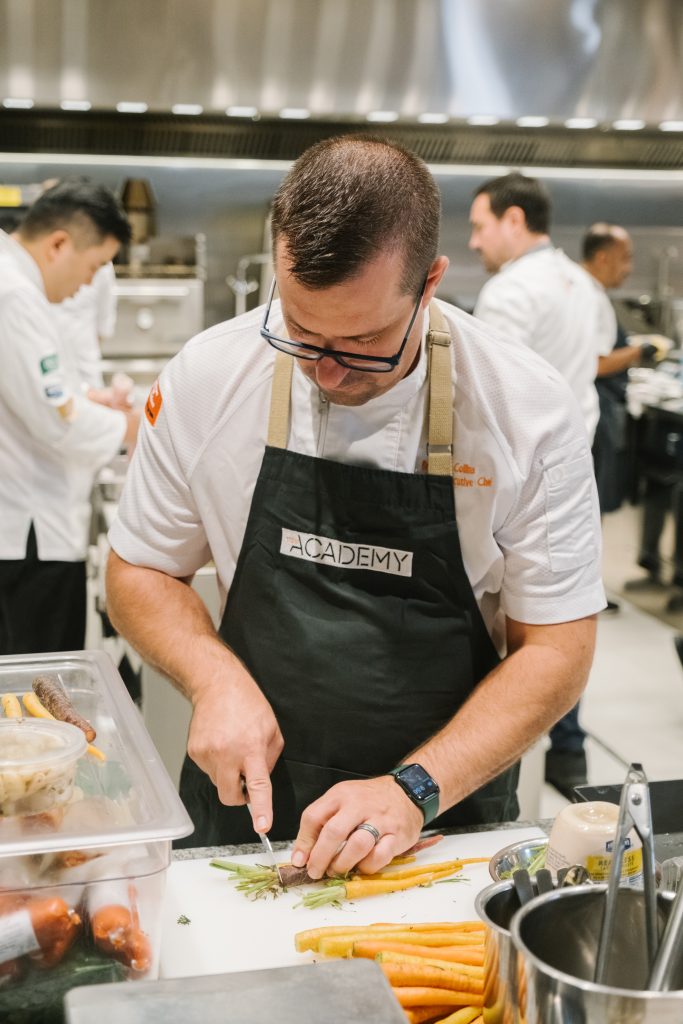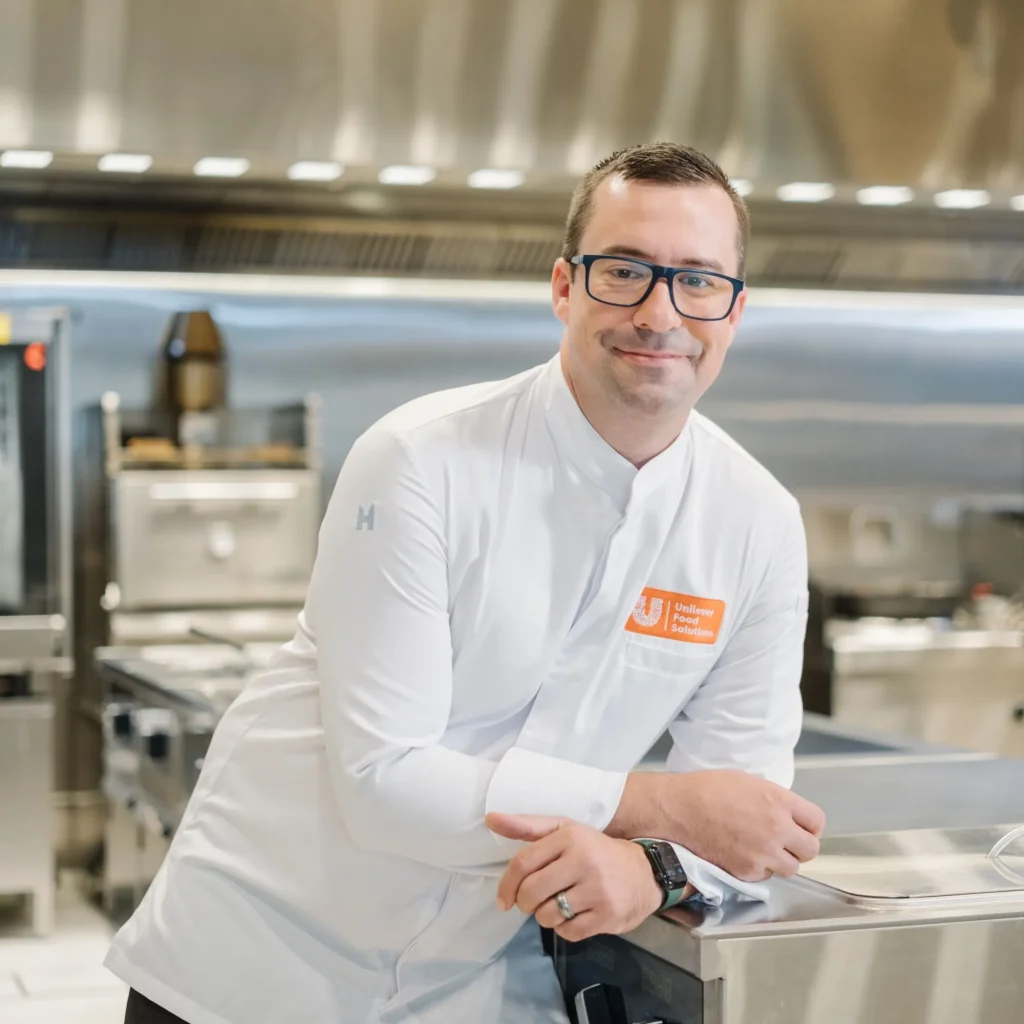LOW-WASTE MENUS 
Maximizing Creativity
Maximizing Creativity
Your leftover legumes are destined for a second life and your offcuts of oxtail are about to become something tasty, like the carrot top pesto created by Chef Brandon Collins. It’s time to push the boundaries of your culinary creativity and turn your waste into a winning dish.
The rising cost of produce means that we need to be resourceful in order to reduce waste, whether that’s using the whole ingredient to create more components or sharing excesses with other restaurants. Reducing waste is no longer just about sustainability, it’s about maximizing the potential of ingredients and creating unique food stories that bring communities together.


HOW TO GET
Creative WITH WASTE
With
Chef Brandon Collins
Words by
Ryan Cahill
“Waste” has always been a dirty word when it comes to food. Specifically, it conjures up images of rotting vegetable offcuts piled up at the bottom of the bin. In recent years, buzzwords like “upcycled” and “ugly foods” have helped to shift the negative narrative surrounding food waste, and chefs are embracing the idea of getting creative with would-be waste.

33% of all food produced globally goes to waste
“Anything that you don’t throw into the bin is going to translate to dollars on the plate.”
With the cost of produce rising year-on-year, it’s never been more important to make use of every last edible part of the ingredients we use. This is something Brandon Collins, Executive Chef for UFS North America, is passionate about. Anything that you don’t throw into the bin is going to translate to dollars on the plate,” he explains. “Utilising would-be waste provides excitement for customers and also forces us chefs to be more creative and adventurous.”
“One of the very first ways that I got into utilizing waste was thinking about the things that I knew were edible,” Brandon shares. “Cores of cauliflower, broccoli stems, mundane things that we often throw out can be turned into soups. Or perhaps take those stems and slice and pickle them.”
Brandon adds, “One of the things that I’ve done with banana peels is dice them really small, mix them with vinegar, sugar and a little bit of jalapeño and then use it over oysters. It became a cool mignonette sauce. Super simple, but it brought that beautiful fruitiness of the banana out.”
Chef Brandon Collins offers five tips on how to start your food upcycling journey.
Find the Perfect Pickle Brine
Do Your Research
One of my go-to books is Surplus: The Food Waste Guide for Chefs by Vojtech Végh. It’s amazing and full of useful information.
Eat Global
There are so many cuisines that are based on fermented food, preserved food or the utilization of waste. So start exploring!
Look to the Past
If you look at historic recipes, they utilize everything. Looking back into the past can help propel us into the future and inspire us.
Rethink Waste
Look at what you throw in the bin, or what you traditionally remove from an item and ask yourself if you actually have to remove it. Do I have to peel that carrot? Do I have to peel that banana? Are these things necessary for creating the dish or the flavor profile that I’m looking for? Nine times out of ten, leaving it on actually creates a better dish.
LESS IS MORE:
THE BENEFITS OF A SMALLER MENU
With
Chef Brandon Collins
Words by
Herman Clay
An increasing number of chefs and restaurateurs are realising the importance of data-driven decision making, especially in the face of challenges such as staff shortages. One effective strategy that is gaining momentum is the implementation of smaller menus.
It might seem counterintuitive, but simplifying it can help businesses look after the bottom line while ensuring the customer feels there is great choice on a smaller menu. And it’s equally rewarding for those doing the actual cooking. “Having a smaller menu gives chefs more freedom to explore their creativity without having to compromise on quality or consistency,” says Audrey Crone, Executive Chef of UFS Ireland.
Embracing the concept of a smaller menu can also lead to cost savings and a more sustainable operation. Audrey explains: “If you have a carefully curated, condensed menu, it makes it easier to manage inventory and minimize the amount of perishable items that go to waste.”
Enabling restaurants to optimize their pricing and profit margins is a big part of the appeal of smaller menus. But for Audrey, it all comes back to ensuring greater quality and consistency. “If you’re able to reduce the amount of ingredients coming in the back door, then ultimately you’re in a better position to deliver great food.”
For more information about this tool, click here.

70% of operators believe this trend is set to grow
SPENT GRAIN DETROIT-STYLE FOCACCIA
WITH NDUJA, CARROT AIOLI, CARROT TOP PESTO AND FERMENTED GARLIC CREAM
One of the global top dishes with a high-fiber focaccia base, topped with a pesto made with carrot tops, carrot aioli, fermented garlic, and a kick of spice from Nduja.

Chef Brandon Collins, North America
For Casual Full-Service Restaurants
Cost (€) per portion: 3–4
INGREDIENTS (SERVES 4)
Carrot Top Pesto
- 240g carrot tops, blanched
- 120g spinach, blanched
- zest from 1 pc lemon
- 56g olive oil
- 56ml canola or mild oil
- 1 pc avocado
- 225g parmesan grated, reserve the rind
- salt & pepper, to taste
Carrot Aioli
- 0.25kg Hellmann’s Real Mayonnaise
- 0.25kg orange carrots, tops removed, rinsed, and reserved
- 28g hot sauce
- 28g vinegar, rice or white
- salt & pepper to taste
Assembly
- 1 dough recipe
- 112g low-moisture mozzarella, diced
- 112g Gouda, diced
- 112g carrot aioli
- 25g carrot top pesto
- 25g garlic cream
- 112g Nduja
Fermented Garlic Cream
- 12 pcs fermented garlic cloves, grated
- 225g Legout Cream Soup Base
- 826g water
- 1 pc parmesan rind
- salt & pepper, to taste
Pizza Dough
- 550g spent grain flour
- 295g water warm
- 2 tsp instant yeast
- 2 tsp sugar
- 2 Tbsp olive oil
- all-purpose flour, as needed
Fermented Garlic
- 25 cloves garlic
- 472g water
- 1.5 Tbsp kosher salt
- 1 tsp fennel seeds
- 3 pcs bay leaves
- 1 tsp dried oregano
METHOD
Carrot Aioli
- Rinse carrots and toss with oil.
- Roast at 163°C until tender.
- Let it cool.
- Place all ingredients in a blender and puree until smooth. Set aside.
Carrot Top Pesto
- Place all ingredients in a blender and puree until smooth.
Fermented Garlic Cream
- Combine garlic and spices in a jar.
- Dissolve salt in water and pour over garlic herb mix.
- Let it set on the counter with a loosefitting lid for 4 days.
- Seal and place in fridge until needed.
Pizza Dough
- Mix water and sugar and sprinkle yeast over to bloom.
- Once yeast starts to foam, mix in remaining ingredients.
- Knead dough until smooth – around 4 mins.
- Place in a greased bowl and cover. Let it rise until doubled.
- Knock down the dough and place in the Lloyd blue steel pans: professional Detroit-style pizza pans that are non-toxic, never need any seasoning, and can last for years.
- Let it rise again for about 1 hour.

Chef Brandon Collins
Assembly
- Preheat the oven to 204°C.
- Top dough with diced cheese, making sure to spread across the entire pan.
- Drizzle with garlic cream.
- Bake for 18 mins or until the dough is cooked through and the cheese is crispy on the sides.
- Place Nduja on top of the pizza and let it sit for 5 mins.
- Remove from the pan and drizzle over some carrot aioli and carrot top pesto.
- Cut into 4 pieces.

For Central Production Kitchens:
- Par bake the pizza.
- Shave about 10 mins from the cooking time, allowing it to be finished at the restaurant or home.
- Keep all components separate to create a kit.
- Add xanthan gum to the pesto (approx. 0.1% by weight).
- Replace the fermented garlic with regular garlic.
